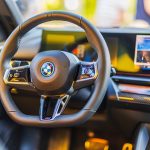1. Introduction to Self-Driving Cars
Self-driving cars, also known as autonomous vehicles, are revolutionizing the way we think about transportation. These vehicles use advanced technology to navigate roads, detect obstacles, and transport passengers without human intervention. By eliminating the need for a driver, autonomous cars have the potential to improve safety, reduce traffic congestion, and enhance mobility for individuals who cannot drive.
What Are Autonomous Vehicles?
Autonomous vehicles are equipped with sensors, cameras, radar, and artificial intelligence (AI) systems that allow them to perceive their surroundings and make driving decisions. These cars rely on complex algorithms and machine learning to interpret data in real-time and follow traffic laws.
How Self-Driving Cars Are Changing Transportation
Self-driving technology is transforming the transportation industry in a variety of ways, including:
- Enhanced Safety: Autonomous systems can react faster than human drivers, helping to reduce accidents caused by human error.
- Increased Accessibility: People with disabilities or limited mobility can gain greater independence with self-driving cars.
- Traffic Management: AI-driven cars can optimize traffic flow, reduce congestion, and improve fuel efficiency.
- Economic Impact: The rise of autonomous vehicles is influencing industries such as ride-sharing, logistics, and public transportation.
Levels of Vehicle Automation
The Society of Automotive Engineers (SAE) defines six levels of vehicle automation, ranging from Level 0 (no automation) to Level 5 (full automation).
| Automation Level | Description |
|---|---|
| Level 0 | No automation; human driver is responsible for all tasks. |
| Level 1 | Driver assistance features such as adaptive cruise control, but human driver still controls the vehicle. |
| Level 2 | Partial automation where the system can control acceleration, braking, and steering, but driver supervision is required. |
| Level 3 | Conditional automation allowing the car to manage certain driving tasks, but human intervention may be needed. |
| Level 4 | High automation, enabling the car to drive itself in specific conditions without human oversight. |
| Level 5 | Full automation where the vehicle requires no human input in any conditions. |
The Future of Self-Driving Technology
As technology continues to evolve, self-driving cars are expected to become more advanced and widely adopted. Companies like Tesla, Waymo, and General Motors are leading the charge in developing autonomous driving systems that could redefine the way we travel.
2. Key Technologies Behind Autonomy
Self-driving cars rely on a combination of advanced technologies to perceive their surroundings, make decisions, and navigate safely. These technologies work together to create a reliable and intelligent system capable of driving without human intervention. Below, we explore the core components that enable vehicle autonomy.
LiDAR: Creating a 3D Map of the Environment
LiDAR (Light Detection and Ranging) is a key sensor used in self-driving cars to measure distances by emitting laser pulses and detecting their reflections. By collecting millions of data points per second, LiDAR creates a detailed 3D map of the surroundings, allowing the car to detect obstacles, road conditions, and other vehicles.
How LiDAR Works
- The sensor sends out laser beams that bounce back from objects.
- The system calculates the time it takes for the light to return.
- It creates a high-resolution 3D representation of the environment.
Cameras: Capturing Visual Data
Cameras help self-driving cars recognize road signs, traffic lights, lane markings, pedestrians, and other vehicles. High-definition cameras are mounted around the vehicle to provide a continuous visual feed, which is processed using advanced image recognition algorithms.
How Cameras Assist in Driving
- Front cameras detect traffic signals and road signs.
- Side cameras monitor lane positioning and blind spots.
- Rear cameras assist with parking and obstacle detection.
Radar: Detecting Objects in Various Conditions
Radar (Radio Detection and Ranging) systems use radio waves to detect nearby objects, calculate their distance, and determine their speed. Unlike LiDAR, radar is less affected by weather conditions, making it useful for detecting moving objects in fog, rain, or darkness.
LiDAR vs. Radar: A Comparison
| Technology | Strengths | Weaknesses |
|---|---|---|
| LiDAR | High precision, detailed 3D mapping | Limited performance in heavy rain or fog |
| Radar | Works well in bad weather, detects object speed | Lower resolution than LiDAR |
AI and Machine Learning: Making Smart Decisions
Artificial Intelligence (AI) and Machine Learning (ML) play a crucial role in self-driving technology. These systems help the car learn from real-world data, predict potential road scenarios, and make split-second driving decisions.
Key AI Functions in Autonomous Driving
- Processing sensor data to understand the surroundings
- Recognizing and classifying objects like pedestrians and vehicles
- Planning safe and efficient driving routes
How These Technologies Work Together
Each of these technologies provides unique information that, when combined, allows a self-driving car to navigate safely:
- LiDAR and cameras create a real-time 3D map.
- Radar detects moving objects and measures speed.
- AI analyzes all inputs and makes driving decisions.
These systems need to operate seamlessly, ensuring that self-driving cars can handle various driving conditions and respond to unexpected situations effectively.

3. How Self-Driving Systems Process Data
Self-driving cars rely on an intricate system of sensors, cameras, and AI-powered software to navigate the world safely. But how do they actually process the vast amounts of data they collect? Lets break it down step by step.
How Autonomous Vehicles Perceive the Environment
Self-driving cars use multiple sensors to build a real-time, 360-degree view of their surroundings. These sensors include:
| Sensor Type | Function |
|---|---|
| LiDAR (Light Detection and Ranging) | Uses laser pulses to create a high-resolution 3D map of the surroundings. |
| Radar | Detects objects and their movement, even in poor weather conditions. |
| Cameras | Identify traffic signals, lane markings, pedestrians, and other objects. |
| Ultrasonic Sensors | Assist in close-range detections, such as parking and low-speed navigation. |
Interpreting Real-Time Data
Once the sensors collect environmental data, the vehicles onboard computer processes it using AI and machine learning algorithms. These algorithms:
- Recognize objects: Identifying other vehicles, people, road signs, and obstacles.
- Predict movements: Calculating how surrounding vehicles or pedestrians might move.
- Monitor road conditions: Detecting lane boundaries, traffic signals, and road hazards.
Making Driving Decisions
With the processed data, the autonomous system makes informed driving decisions in real time. This involves:
Path Planning
The system determines the safest and most efficient route by analyzing road conditions, traffic rules, and surrounding vehicles.
Real-Time Adjustments
As the car moves, it continuously adapts its speed, steering, and braking based on incoming data.
Emergency Responses
The AI can initiate emergency braking, swerve to avoid obstacles, or pull over if it detects a system failure.
By effectively perceiving the environment, interpreting vast amounts of data, and making critical driving decisions, self-driving cars aim to operate as safely and efficiently as human drivers—if not better.
4. Levels of Automation in Autonomous Vehicles
Autonomous vehicles are categorized into six levels of automation, as defined by the Society of Automotive Engineers (SAE). These levels range from Level 0, where the driver has full control, to Level 5, where the vehicle operates entirely on its own without human intervention. Lets take a closer look at the different levels.
Understanding the Six Levels of Driving Automation
Each level represents a step forward in automation capabilities. The table below summarizes the key characteristics of each level:
| Automation Level | Description | Driver Involvement |
|---|---|---|
| Level 0: No Automation | The driver is entirely responsible for controlling the vehicle. No automation features are present. | Full control by the driver. |
| Level 1: Driver Assistance | Some driver assistance features, such as adaptive cruise control or lane-keeping assist, but the driver must remain engaged. | Driver must always monitor and control the vehicle. |
| Level 2: Partial Automation | The vehicle can manage steering and acceleration/deceleration simultaneously, but the driver must always be ready to take over. | Driver supervision is required at all times. |
| Level 3: Conditional Automation | The car can handle certain driving tasks under specific conditions, but human intervention is needed when the system requests. | Driver must be available to take control when necessary. |
| Level 4: High Automation | The car can drive entirely on its own in limited environments, such as geofenced areas, with no driver intervention needed in those conditions. | Driver intervention is not required in designated areas. |
| Level 5: Full Automation | The vehicle is entirely autonomous and does not need a human driver. It can operate in any environment without human input. | No driver needed at all. |
How These Levels Impact the Future of Transportation
As technology advances, more vehicles are incorporating higher levels of automation. Today, most commercially available cars are at Level 2, with some manufacturers testing Level 3 features. However, reaching Level 5 will require overcoming significant technical and regulatory challenges.
Why Understanding Automation Levels Matters
Knowing these levels is essential for both car manufacturers and consumers. It helps set expectations for what self-driving vehicles can and cannot do, ensuring that drivers remain aware of their responsibilities when using these technologies.
5. Challenges and Future of Self-Driving Cars
Major Challenges Facing Autonomous Vehicles
Self-driving cars have come a long way, but there are still several challenges that need to be addressed before they can become a widespread reality. These challenges include safety concerns, government regulations, and public acceptance.
Safety Concerns
One of the biggest challenges with self-driving cars is ensuring they are as safe—or even safer—than human drivers. While autonomous vehicles have the potential to reduce accidents caused by human error, issues like sensor failures, unpredictable road conditions, and cybersecurity risks must be carefully managed.
Regulations and Legal Barriers
Governments around the world are still working on creating regulations for self-driving cars. Laws regarding liability in case of an accident, data privacy, and proper testing procedures vary by country and even within different states in the U.S. Without clear legal frameworks, mass adoption remains difficult.
Public Acceptance
Even if self-driving technology improves significantly, gaining public trust is another hurdle. Many people are skeptical about riding in a fully autonomous vehicle, fearing potential malfunctions or ethical dilemmas in decision-making situations.
The Future of Self-Driving Cars
Despite these challenges, the future of autonomous vehicles looks promising. Companies and researchers are continuously developing smarter and safer technologies to make self-driving cars more efficient.
Advancements in AI and Machine Learning
Future self-driving cars will rely even more on artificial intelligence (AI) and machine learning to improve their ability to navigate complex environments. These advancements will make vehicles better at identifying hazards and making faster, safer decisions.
Improved Sensors and Perception Systems
As sensor technology improves, self-driving cars will be able to detect objects more accurately and operate more effectively in different weather and lighting conditions.
| Challenge | Future Solution |
|---|---|
| Safety issues and sensor limitations | Improved AI decision-making and enhanced sensor accuracy |
| Regulatory barriers | Collaboration between automakers and governments for standardized laws |
| Public skepticism | Better education and real-world testing to prove reliability |
More Connectivity and Smart Infrastructure
Future cities may develop infrastructure specifically designed for autonomous vehicles, such as smart traffic signals and dedicated lanes. Increased vehicle-to-vehicle (V2V) and vehicle-to-infrastructure (V2I) communication will enhance overall traffic efficiency.
Fully Autonomous Systems
While most self-driving cars today still require human intervention in certain situations (Level 3 or Level 4 automation), we are moving closer to fully autonomous Level 5 vehicles that do not need any human input at all.
The road ahead for self-driving cars is challenging, but as technology continues to evolve, we get one step closer to a future where autonomous vehicles are a normal part of everyday life.


